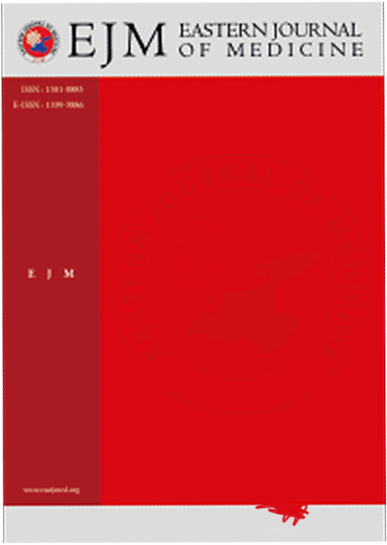Use of Sodium Glucose Cotransporter-2 Inhibitor and Thiol Disulfide Homeostasis in Type -2 Diabetic Patients
Saliha YILDIZ1, Mehmet Ali Akgündüz2, Salim neselioglu3, Ozcan EREL3, murat alay11Department of Endocrinology, Van Yuzuncu Yil University, Van, Turkey2Department of Internal Diseases, Van Education and Research Hospital, Van, Turkey
3Department of Biochemistry, Yıldırım Beyazit University, Ankara, Turkey
INTRODUCTION: To investigate the presence of antioxidant activity in sodium glucose cotransporter-2 inhibitors (SGLT-2I), which have a preventive effect on the progression of complications since reactive oxygen species damage has a major effect on diabetes morbidity and mortality.
METHODS: Thiol, disulfide and ischemia-modified albumin levels were measured in the blood of type 2 diabetes mellitus (DM) patients who were using SGLT-2I for at least one year and those who were not using this drug.
RESULTS: Data of 53 patients using SGLT-2I and 62 patients not using SGLT-2I were analyzed. Gender and age were similar in the two groups (p: 0.293, 0.772, respectively). DM duration, HbA1C level and number of drug types used in the combination were higher in the SGLT-2I group (p: 0.003, 0.000, and 0.000, respectively). Disulfide/native thiol was significantly higher in the SGLT-2I group (4.29±1.65 vs 4.06±1.99, p: 0.038). In the analyses of the groups under 50 years of age, female gender, HbA1C≥7, no complications and concomitant use of dipeptidyl peptidase-4 inhibitor (DPP-4I), the disulfide/native thiol ratio was significantly higher in SGLT-2I users than in non-users (p: 0.072, 0.021, 0.040, 0.008 and 0.032, respectively). In the analysis of patients with DM duration of less than 10 years, the disulfide/native thiol ratio in the SGLT-2I group was significantly higher than those who did not use the drug (p: 0.048). Native thiols were statistically similar in all group analyses (p>0.05). Again, IMA was similar in all group analyses (p>0.05)
DISCUSSION AND CONCLUSION: SGLT-2I use affects thiol disulfide homeostasis more especially in those younger than 50 years, with diabetes duration <10 years, without complications, HbA1C≥7 and using DPP-4I together. The fact that no decrease was detected in native thiol suggests that this effect is more in the antioxidant direction.
Manuscript Language: English














